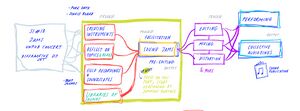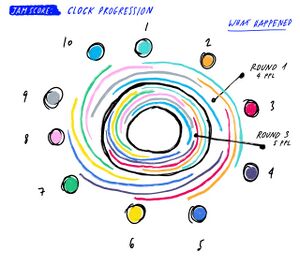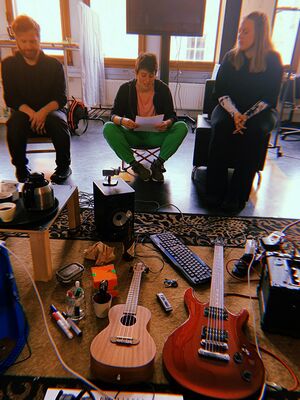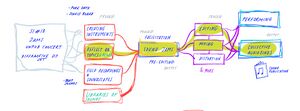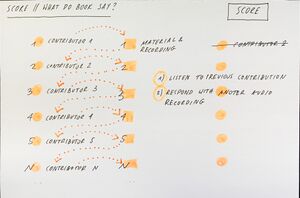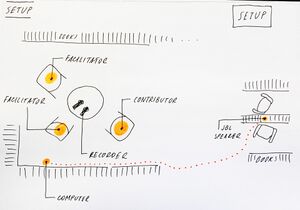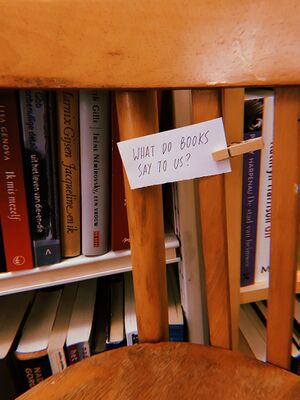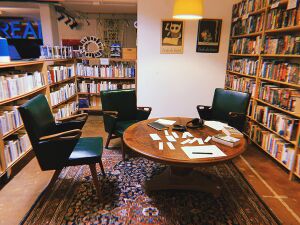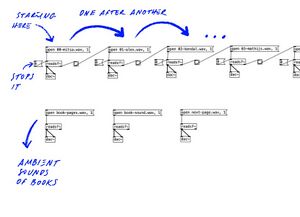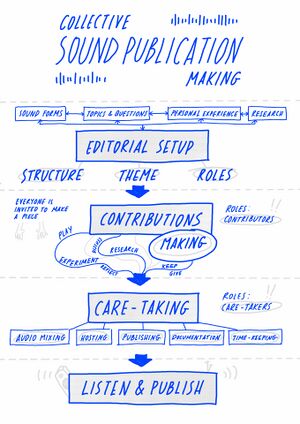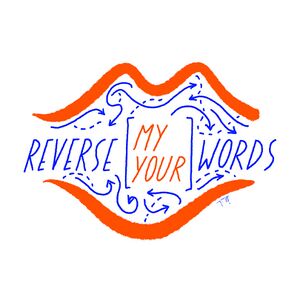Sound jams research
about
This page is about the collective research on sound publications, audiozines and sound jams by mits🤖 & ☾ Ål Nik ☾.
Our research has started with facilitation of sound jams and it explores various directions simultaneously. We have brainstormed about:
# ways to create a collective sound publication [sound jams] // october-november 2022
-we will make series of facilitated jams in order to explore various ways to create sound publications and audiozines in group
-we understand jams as collective moments of listening and responding - we create improvised sound pieces together no matter if we have musical training or not
-we will explore various topics through introducing reads and different ways to conduct a jam session
-we will try out collectively several aspects of our individual research
-we will ask for consent for recording the sessions and for editing them later
# ways to collect sound // tba
-we are interested in exploring soundscapes
-field recordings will also happen during facilitated jams - some jams will take place outside and will explore soundscapes
-create instruments and sounds (also with pure data, interfaces for generating recordings)
# ways to edit sound pieces and create audiozines [mixing and editing] // tba
-we would like to explore ways to mix and edit sound
-we are interested in finding out why we edit in a particular way
-we are going to research the theoretical background of mixing and editing, too
sound jams
_01 M&Ms @ PZI
// 10-10-2022
context
The jam was the first of the series in our research. As an opening one, we focused on a topic: Deep Listening (a concept brought to life by artist Pauline Oliveros). The participants were invited to read some extracts from her book with the same title and to jam while trying to apply listening and paying attention techniques to their performance in the group. The jam was following the structure of a clock while progressing.
participants
mitsa, jian, kamo, miriam, alex, emma, manetta, gersande, chae, joseph [in order of the clock]
feedback & reflections
-overall: it was nice; a well-facilitated jam
-the clock structure - helps to listen to the others and move around organically; frustrating when you want to play with someone or some instrument specifically
-instruments shape the experience - some instruments (and/or for some participants) require more focus and it makes it difficult to focus on listening & responding
-improvised instructions in the middle are confusing when the sign language is not introduced ahead / to be given really clearly
-everyone playing at the same time is confusing - climbing up is better (create a slow progression)
-different instruments - different volume and space-taking - great for learning to listen and pay attention
-maybe try giving instruments to people that they never used before - to put everyone at a similar "start"
-visual score will help people without musical training or who are more visual
-warming up can include a moment to explore the instruments
-it will be better if the 5th person starts before the 1st stops
-keep doing the jams with having some of the same participants over and over again - for being able to experiment more and try different things
-don't be afraid to ask people to come to jams when you want to try out new things
learnings
What worked:
-the text in relation to the jam. Deep listening a nice starting point
-the facilitation through the clock score can be noticed when you listen to the recording
-the plethora of sounds that are produced. Strings, processed recordings, paper, voices clean and dissolved, synths, a glass of beer, a harmonica. it is a diverse improvised soundscape.
-I can hear a lot of moments of listening and responding.
What could be improved:
-take into concideration the amplitude dynamics and the complexity of each instrument. Worke more on the idea of how can the different voices take as much space as they desire while not creating an unwanted unbalance with the rest.
-reflect on how to disrupt the idea of the lone improviser.
-take into concideration the dynamics of a group with different experiences around sound and improvisation, while facilitating. How this affects each different session depending on the theme.
-if we improvise instructions or change the rules during the jam - make sure everyone understands clearly the change
-progression works well for the clock structure - we can create a score that progresses with each round
-always have two recorders working
recordings & mix
⟿ diffractive mixing - edit 1.0
zine
⟿ download the pdf zine here
⟿ download the A4 pdf for printing & folding here
wip
▶ working pad - preparation of the session
_02 What do books say? @ Leeszaal
// 17-10-2022
report
_facilitators // Alexandra Nikolova and mitsitron
_location // Leeszaal, Rotterdam
_number of participants // 12
_format // workshop
_instruments // two Zoom H1 Handy stereo recorders, voices, room ambience
_schedule // 2 hours. Each contributor took around 7-10 minutes.
_process // The structure of the sound jam was to invite the contributors to join one after another. It took place in a cosy corner of the library over a round table and three armchairs where the two facilitators and one contributor were seated. A contributor listened to the recording of the previous one, reflected upon it and then made another recording in response to what they listened to. In order to start the jam, the two facilitators recorded the first two pieces. The invitation was to pick a book from a shelf and read a paragraph of their choice. The second facilitator listened to the first one’s recording, reflected for a little while about its content and then picked another book that for them responded to what they listened to. There were a few rounds like that until the facilitators opened the instructions to "respond to the previous audio by recording anything". As a result, the next contributor decided to record sounds from the room. The same approach continued for a few rounds until another contributor wanted to read from the books again.
The first moment of publishing of the sound pieces happened on spot via a sound installation. A small speaker was subtly hidden between the books in the library and each new recording was added to the queue. The visitors of the library were discovering the readings and sounds while walking by the particular spot. The second publishing moment was an edited audio mix with all of the contributions, made by the facilitator with the contributors’ consent.
_observations // The structure of this sound jam allowed the facilitators to play the role of editors and publishers of the final sound publication. The contributors were aware of the process and enjoyed listening and responding with an audio recording. They found the sound jam accessible, allowing them to use sound as a medium even though not many of them worked with it before. Some of them used their voice to produce the sonic piece, while others preferred to record a soundscape in the room or other people talking. The process was quite strict but at the same time, gave them the freedom to choose how to approach the assignment and that made them content with the experiments and their recordings. With this structure, the contributors only could hear the recording before them and they do not know who are the other makers in this sound publication. Thus, everyone had the same role as a contributor, with the exception of the two facilitators. The sound jam was accessible and inclusive as such and without the need to work on creating a specific group dynamic and putting people in the same place at the same time. The participants enjoyed the process of listening to the creation of someone else and responding to it.
▶ documentation pad
publications
_version 1 // audio live mix with Pd // The first try for mixing the audio contributions and playing them one after another was done with Pure Data. No matter with which one we start, they will played in the right order afterwards. I also added some additional sounds that could be started and stopped at any time - of books' pages being turned.
_03 R m for Sooound Elective @ WDKA
// 16/20-01-2023
context
This elective was a 2-week sound workshop, organised and facilitated by Naomi Jansen and me, Alexandra Nikolova (Ål Nik). With this class, we wanted to create space for students to experiment with sound for their research and artistic practice. We planned and developed the workshop together, where Naomi worked on creating the workshops and activities of experimentation during the first week and i developed the process of collective creation of sound publication during the second week.
During the elective R m for Sooound, we collectively explored sound as a concept and a research and publishing medium. Through various group and individual exercises, we gave room to ways in which sound can be produced, experienced and transformed. The elective took place at WdKA, in which we had our own space to work in and with. The focus did not lie on the technical aspects of sound production, but on the conceptual and poetic questions that can be asked when using sound in any art practice. For example: How could we translate an image to a sound and vice versa? How does our experience of sound differ per person? And what is the sound of ? Next to giving room to sound, the focus of this elective was also on collectivity. In the first week this meant that through various exercises and workshops, we were continuously interpreting, repeating and transforming sounds that we produced. In the second week, the collection of sounds of week one formed the basis of working towards a collective sound publication. The elective was based on the WDKA project Room for Sound. An artist in residency for students and staff, in which in exchange for the Room, residents have to record and upload a sound a day. This can range from an in depth talk about their work to a short observational soundscape.
[about] Sound is something that we share, either when communicating with each other or as an omnipresent element in our daily life. However, we often take it for granted. Sound can be experienced in many different ways and can take various forms on itself or in relation to different media. Therefore, when you give room to it, sound can become an extension or essential part of any art practice. In this elective we worked towards producing a collective sound publication (which could take any form, for example an installation, performance or album). This publication was be a combination of individual experiments and collective works, made during the two weeks.
programme
week 1 - experiments // process facilitated by Naomi
The first week is exploration week. The students are invited to play with sound in various exercises and discover they way they approach sound; and what part does it take in their research and artistic practice. Each day has a theme and invitation - to listen, to collect, to translate, to play, to resonate.
_outcome: publication - booklet by Naomi
week 2 - sound publication making // process facilitated by Alex
After reflecting on all of their experiments during the first week, the students were brainstorming on what are the themes that bring them together. Then, the week followed the collective sound publication making process, described below:
_outcome: sound installation + sound publication by the makers
method
a collective sound publication making
The process of making the sound publication is taking place in the second week of the workshop. The students were invited to create concept of their collective piece (editorial setup), divide into smaller groups to create contributions (day 1 and 2) and then to split into care-takers groups to finalise the different elements of the sound publication among themselves (day 3 and 4). Finally, on day 5 the whole group experiences the final outcome.
This process is based on XPUB's 18th special issue concept - Radio Implicancies, facilitated by Femke Snelting. During the weekly releases, we reflected on reads and topics addressing various social challenges and produced sound-based publications as a group. Each week we divided in small groups - contributions teams to make the sounds and a care-taker group (of 2-3 students) to make the final release. For this sound jam, the students decided they wanted to do a sound installation at the back stairs of the WH building. In addition, the experience to be documented and an audio mix to be published afterwards.
With this sound jam, the process was visualised in a more detailed way by me. I introduced the structure in a different way: already organised for the bachelor students: the contributions making phase was clearly divided by the care-taking phase and everyone in the group took a role in both of the phases. During the contrubutions phase, the participants create the editorial setup as a whole group and then split in smaller teams to produce the audio files. This phase took 2 days (working time 10:00-16:00 h). Then, all of them got back into the whole group and listened to the sounds. They took notes on where the creations fit into the editorial setup and structure. Afterwards, they split again in smaller groups - named "care-taking groups". For this part, I came up with the idea to create 5 groups, so everyone on the whole team has a role here too:
▶ audio-mixing (4 students)
-get all the contribution audio files -edit them into one audio mix -export the audio mix -provide it to the Publishing, Hosting & Documentation care-takers
▶ hosting (5 students)
-create space for the whole group to listen & experience the sound publication -prepare the space: technical setup, physical space design and organisation, environment for listening/experiencing the sound -find a way to present the other care-taker groups’ work to the whole group
▶ publishing (3 students)
-get how everyone wants their name to be written -decide how to publish the audio mix -write down an introduction/description of the whole publication -create an image -publish it -bonus: they can also interview the contributors about their works, intentions etc.
▶ time-keeping (1 student)
-make sure the process goes smooth -make sure everything is happening on time and everyone is meeting the deadlines -check on how people are doing -help them organise meet-ups when needed
▶ documentation (3 students)
-document the whole process (take photos, videos, illustrations, audio recordings, interviews etc.) -organise the visuals, written materials and sounds in MS teams folders -make sure to collect the final outcomes that are published, but also work-in-progress pieces; quotes from the makers and anything else that is part of the process
_04 Reversed Words @ online
// 02-2023
context
The [reversed words] sound jam is an experiment to co-create a sound publication through an open call online. The invitation to the potential participants is to reflect on a topic that everyone can relate to - in this case, whenever we are saying hurtful words, or someone else is saying them to me. When the moment of regret hits immediately after the words are already told and there is not turning back. What would we like to have kept to ourselves? Or what we only said in a moment of anger, fear? The contributors are invited to reflect upon those questions and to share - either their voice recordings, or a text which I will record myself and edit.
intention
What do I want to test with this jam? What research question will answer? What is the focus here?
invitation
The invitation and original instructions are published here.

